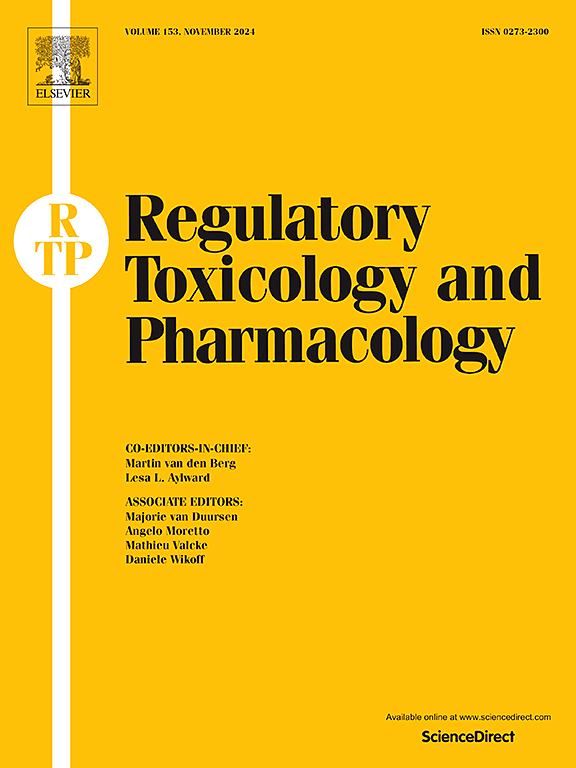目前还没有从六种中剔除兔子眼睛:TTT并没有预测农药配方的体内眼睛刺激分类的全部范围
IF 3
4区 医学
Q1 MEDICINE, LEGAL
引用次数: 0
摘要
自2015年被采用为测试指南(EIT, OECD测试指南(TG) 492)以来,EpiOcular™眼睛刺激测试一直是鉴定对眼睛无刺激性的农用化学品配方(根据全球化学品统一分类和标签系统,GHS,既不是第1类也不是第2类)的体外方法选择。然而,对于严重的眼睛损伤(GHS第1类),没有一种体外试验方法,包括牛角膜不透明和渗透性试验(BCOP, OECD TG 437和方案修改),分离鸡眼试验(ICE, OECD TG 438),眼睛刺激试验(OECD TG 496)或绒毛膜尿囊膜鸡蛋试验(HET-CAM)试验证明足够敏感,无法正确识别被归类为严重眼睛损伤的农药制剂。2022年,经合组织通过了一项新的体外测试指南,用于识别引起严重眼睛损伤、眼睛刺激和不需要对眼睛刺激进行分类的化学品(经合组织TG 492B)。然而,在这种毒性时间(TTT)测试方法的正式验证研究中,农药制剂未被包括在内。为了评估该测试对农用化学品配方的适用性,在TTT中评估了25种具有历史体内数据的配方。TTT正确预测了0%、90%和50%的农药配方,这些农药配方分别被体内数据分类为1、2和“未分类”三类。TTT预测三类农药配方的总体准确性为52%。因此,为了促进对农用化学品配方的全范围眼部刺激的非动物鉴定,必须修订测试方案和/或预测模型,或调整分类指南,以与人类相关的体外测试保持一致,而不是依赖体内Draize数据作为参考点。本文章由计算机程序翻译,如有差异,请以英文原文为准。
Not yet nixing rabbit eyes from the six: the TTT is not predicting the full range of in vivo eye irritation classifications for agrochemical formulations
Since its adoption as a test guideline (EIT, OECD test guideline (TG) 492) in 2015, the EpiOcular™ eye irritation test has been the in vitro method of choice to identify agrochemical formulations non-irritant to the eye (neither category 1 nor 2, according to the Globally Harmonized System of Classification and Labelling of Chemicals, GHS). For serious eye damage (GHS category 1), however, none of the in vitro test methods including the bovine cornea opacity and permeability test (BCOP, OECD TG 437, and protocol modifications), the isolated chicken eye test (ICE, OECD TG 438), the ocular irritation assay (OECD TG 496) or the hen's egg test on the chorioallantoic membrane (HET-CAM) assay proved sufficiently sensitive to correctly identify agrochemical formulations classified as seriously eye damaging in vivo. In 2022, the OECD adopted a new in vitro test guideline for identifying chemicals inducing serious eye damage, eye irritation, and chemicals not requiring classification for eye irritation (OECD TG 492B). However, within the formal validation study of this time-to-toxicity (TTT) test method, agrochemical formulations were not included. To assess the applicability of this test to agrochemical formulations 25 formulations with historical in vivo data were assessed in the TTT. The TTT correctly predicted 0 %, 90 % and 50 % of the agrochemical formulations which were classified by the in vivo data into the three categories 1, 2 and “not classified”, respectively. The overall accuracy of the TTT to predict agrochemical formulations of the three categories was 52 %. Therefore, to facilitate non-animal-based identification of the full range of ocular irritation of agrochemical formulations, testing protocols and/or prediction models must be revised or classification guidelines should be adjusted to align with human relevant in vitro testing rather than relying on in vivo Draize data as a reference point.
求助全文
通过发布文献求助,成功后即可免费获取论文全文。
去求助
来源期刊
CiteScore
6.70
自引率
8.80%
发文量
147
审稿时长
58 days
期刊介绍:
Regulatory Toxicology and Pharmacology publishes peer reviewed articles that involve the generation, evaluation, and interpretation of experimental animal and human data that are of direct importance and relevance for regulatory authorities with respect to toxicological and pharmacological regulations in society. All peer-reviewed articles that are published should be devoted to improve the protection of human health and environment. Reviews and discussions are welcomed that address legal and/or regulatory decisions with respect to risk assessment and management of toxicological and pharmacological compounds on a scientific basis. It addresses an international readership of scientists, risk assessors and managers, and other professionals active in the field of human and environmental health.
Types of peer-reviewed articles published:
-Original research articles of relevance for regulatory aspects covering aspects including, but not limited to:
1.Factors influencing human sensitivity
2.Exposure science related to risk assessment
3.Alternative toxicological test methods
4.Frameworks for evaluation and integration of data in regulatory evaluations
5.Harmonization across regulatory agencies
6.Read-across methods and evaluations
-Contemporary Reviews on policy related Research issues
-Letters to the Editor
-Guest Editorials (by Invitation)

 求助内容:
求助内容: 应助结果提醒方式:
应助结果提醒方式:


